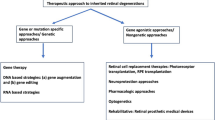Abstract
Background
The extent of site and tissue-associated immune privilege is of great interest in transplantation experiments involving the CNS. In the present paper we have explored neuroretinal immune privilege by transplantation to a non-immune privileged site.
Methods
Fetal and adult full-thickness rabbit neuroretinal grafts were placed in the subconjunctival space of immunocompetent rabbit hosts. Morphological examination was performed after 2–31 days (fetal grafts, n = 46), and after 8 days (adult grafts, n = 4).
Results
Hematoxylin and eosin-stained sections and immunohistochemistry directed against microtubule-associated protein 2 (MAP2) revealed surviving grafts containing retinal neurons in the majority of eyes with fetal grafts. In all specimens, a mild inflammatory reaction was evident as seen with major histocompatibility complex class II (MHC-II) labeling. Short-term grafts survived well and displayed lamination and rosette formation whereas older grafts appeared more disorganized and were more often rejected. Müller cell fibers labeled with glial fibrillary acidic protein (GFAP) were present in grafts from 15 days and onwards. Adult grafts were destroyed after 8 days.
Conclusions
Allogeneic fetal full-thickness neuroretinal transplants can survive for several weeks in a non-immune privileged environment in which adult grafts are rapidly rejected. Fetal grafts gradually shrink, lose their architecture and go through a glial transformation accompanied by low-grade inflammation. The rabbit neuroretina thus appears to enjoy partial immune privilege, the extent of which depends on the development state of the tissue. The characterization of neuroretinal immune privilege will hopefully influence future clinical trials of retinal transplantation.




Similar content being viewed by others
References
Turner JE, Blair JR (1986) Newborn rat retinal cells transplanted into a retinal lesion site in adult host eyes. Brain Res 391:91–104
Medawar PB (1948) Immunity to homologous grafted skin: III. The fate of skin homografts transplanted to the brain, to the subcutaneous tissue, and to the anterior chamber of the eye. Br J Exp Pathol 29:58
Jiang LQ, Jorquera M, Streilein JW (1993) Subretinal space and vitreous cavity as immunologically privileged sites for retinal allografts. Invest Ophthalmol Vis Sci 34:3347–3354
Wenkel H, Streilein JW (2000) Evidence that retinal pigment epithelium functions as an immune-privileged tissue. Invest Ophthalmol Vis Sci 41:3467–3473
Jiang LQ, Jorquera M, Streilein JW (1994) Immunologic consequences of intraocular implantation of retinal pigment epithelial allografts. Exp Eye Res 58:719–728 doi:10.1006/exer.1994.1069
Jiang LQ, Streilein JW (1991) Immune responses elicited by transplantation and tissue-restricted antigens expressed on retinal tissues implanted subconjunctivally. Transplantation 52:513–519 doi:10.1097/00007890–199109000–00025
Ng TF, Osawa H, Hori J, Young MJ, Streilein JW (2002) Allogeneic neonatal neuronal retina grafts display partial immune privilege in the subcapsular space of the kidney. J Immunol 169:5601–5606
Ghosh F, Johansson K, Ehinger B (1999) Long-term full-thickness embryonic rabbit retinal transplants. Invest Ophthalmol Vis Sci 40:133–140
Wassélius J, Ghosh F (2001) Adult rabbit retinal transplants. Invest Ophthalmol Vis Sci 42:2632–2638
Ghosh F, Engelsberg K, English RV, Petters RM (2007) Long-term neuroretinal full-thickness transplants in severely degenerated rhodopsin transgenic pigs. Graefes Arch Clin Exp Ophthalmol 245:835–846 doi:10.1007/s00417–006–0437–9
Ghosh F, Rauer O, Arnér K (2008) Neuroretinal xenotransplantation to immunocompetent hosts in a discordant species combination. Neuroscience 152:526–533 doi:10.1016/j.neuroscience.2007.12.035
Jiang LQ, Streilein JW (1990) Immunologic privilege evoked by histoincompatible intracameral retinal transplants. Reg Immunol 3:121–130
Bergström A (1994) Embryonic rabbit retinal transplants survive and differentiate in the choroid. Exp Eye Res 59:281–289 doi:10.1006/exer.1994.1109
Okabe S, Shiomura Y, Hirokawa N (1989) Immunocytochemical localization of microtubule-associated proteins 1A and 2 in the rat retina. Brain Res 483:335–346 doi:10.1016/0006–8993(89)90178–9
Schnitzer J (1988) Immunocytochemical studies on the development of astrocytes, Muller (glial) cells, and oligodendrocytes in the rabbit retina. Brain Res Dev Brain Res 44:59–72 doi:10.1016/0165–3806(88)90118–6
Ghosh F, Larsson J, Wilke K (2000) MHC expression in fragment and full-thickness allogeneic embryonic retinal transplants. Graefe’s Arch Clin Exp Ophtahalmol 238:589–598
Ghosh F, Bruun A, Ehinger B (1999) Immunohistochemical markers in well-laminated retinal transplants. Ophthalmic Res 31:5–15 doi:10.1159/000055507
Layer PG, Rothermel A, Willbold E (2001) From stem cells towards neural layers: a lesson from re-aggregated embryonic retinal cells. Neuroreport 12:A39–A46 doi:10.1097/00001756–200105250–00001
Bergström A, Ehinger B, Wilke K, Zucker CL, Adolph AR, Aramant R et al (1992) Transplantation of embryonic retina to the subretinal space in rabbits. Exp Eye Res 55:29–37 doi:10.1016/0014–4835(92)90088-A
Boulanger LM, Shatz CJ (2004) Immune signalling in neural development, synaptic plasticity and disease. Nat Rev Neurosci 5:521–531 doi:10.1038/nrn1428
Gery I, Mochizuki M, Nussenblatt RB (1986) Retinal specific antigens and immunopathogenic processes they provoke. Prog Retin Eye Res 5:75–109
Wang HM, Kaplan HJ, Chan WC, Johnson M (1987) The distribution and ontogeny of MHC antigens in murine ocular tissue. Invest Ophthalmol Vis Sci 28:1383–1389
Broekhuyse RM, Kuhlmann ED (1989) Assay of S-antigen immunoreactivity in mammalian retinas in relation to age, ocular dimension and retinal degeneration. Jpn J Ophthalmol 33:243–250
Engelsberg K, Johansson K, Ghosh F (2005) Development of the embryonic porcine neuroretina in vitro. Ophthalmic Res 37:104–111 doi:10.1159/000084252
Engelsberg K, Ghosh F (2007) Transplantation of cultured adult porcine neuroretina. Cell Transplant 16:31–39
Emgård M, Blomgren K, Brundin P (2002) Characterisation of cell damage and death in embryonic mesencephalic tissue: a study on ultrastructure, vital stains and protease activity. Neuroscience 115:1177–1187 doi:10.1016/S0306–4522(02)00480–3
O’Malley MB, MacLeish PR (1993) Induction of class I major histocompatibility complex antigens on adult primate retinal neurons. J Neuroimmunol 43:45–57 doi:10.1016/0165–5728(93)90074–9
Bok D, Zhang X (1998) Transplantation of retinal pigment epithelial cells and immune response in the subretinal space. Invest Ophthalmol Vis Sci 39:1021–1027
Author information
Authors and Affiliations
Corresponding author
Additional information
Supported by the Faculty of Medicine, Lund University, the Crown Princess Margaret Committee for the Blind, the Swedish Research Council. The authors have no financial relationship with the sponsoring organizations.
The authors have full control of all primary data and agree to allow Graefe’s Archive for Clinical and Experimental Ophthalmology to review the data if requested.
Rights and permissions
About this article
Cite this article
Ghosh, F., Rauer, O. & Arnér, K. Immune privilege of allogeneic neuroretinal transplants in the subconjunctival space. Graefes Arch Clin Exp Ophthalmol 246, 1715–1722 (2008). https://doi.org/10.1007/s00417-008-0933-1
Received:
Revised:
Accepted:
Published:
Issue Date:
DOI: https://doi.org/10.1007/s00417-008-0933-1




